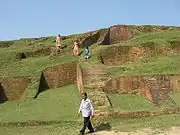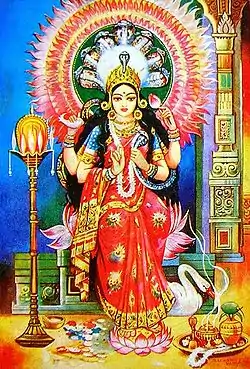Manasamangal Kāvya (Bengali: মনসামঙ্গল কাব্য) is recognized as the oldest of the Mangal-Kāvya, chronicling the establishment of the snake-goddess Manasa's worship in Bengal. Initially, Manasa was worshipped by the Dravidians, who hoped she would safeguard them from snake-related dangers. The goddess holds alternative names such as Bisahari, Janguli, and Padmavati.[1]
Story

The narrative of Manasamangal commences with the merchant Chandradhar, or Chand Sadagar, who initially conflicts with Manasa but eventually becomes a devout worshipper. Manasa aspires to convert Chand, a staunch devotee of Shiva, to her worship. However, he not only refuses to worship her but also denies her deity status. In retaliation, Manasa ruins seven of Chand's ships and takes the lives of his sons. Behula, the new bride of Chand’s youngest son, Lakhindar, challenges the goddess with her unwavering courage and deep love for her husband, subsequently reviving Chand’s sons and their ships. Only after accomplishing this does Behula return home. The tale essentially portrays human resilience against divine cruelty, showcasing Chandradhar and Behula as robust, determined individuals during an era when common people were often suppressed and humiliated.
Villages Named After the Kavya

Villages such as Baidyapur, Hasanhati, and Udaypur owe their names to the Kavya.
| Village Name | Naming Origin |
|---|---|
| Baidyapur | Named because local 'Baidyas' (doctors) attempted and failed to revive Lakhindar as Behula transported him through the village. |
| Hasanhati | The village where people laughed at Behula during her journey. |
| Udaypur | Named for the place where the sun rose during Behula’s voyage. |
Poets of Manasamangal Kavya
The original poet of this medieval Bengali literature genre may have been Kana Haridatta (c. 13th century), but his works are no longer extant. His name is referenced in the works of both Bijay Gupta and Purushottam. Subsequent poets, including Purushottam, Narayan Deb (c. 15th century), Bijay Gupta, and Bipradas Pipilai, created their own versions of Manasamangal. Bijay Gupta's Manasamangal (or Padmapuran) (1484–85) is renowned for its rich literary quality and is perhaps the most popular version. Bipradas Pipilai's Manasabijay (1495–96) was also composed during this period.[2] Narayan Deb's composition is also known as Padmapuran.
Ketakadas Kshemananda (c. 17th century),[2] Jagajjiban Ghoshal (c. 17th century), and Jibankrishna Maitra (c. 18th century) were also contributors to this genre.[3]
See also
- Mangal-Kāvya
- Chaitanya Bhagavata
- Tulsidas
- Bhakti
- Bengali literature
- Gokul Medh - claimed links to Manasamangal Kavya
- Kasba - claiming to be the site of Champaknagari
References
- ↑ p.145, Bengali Literature, Annada Shankar Ray and Lila Ray, Paschimbanga Bangla Akademi, Kolkata
- 1 2 Majumdar, R. C. (ed.) (2007). The Mughul Empire. Mumbai: Bharaitya Vidya Bhavan. ISBN 81-7276-407-1. p. 558.
- ↑ Sen, Sukumar (1991, reprint 2007). Bangala Sahityer Itihas. Vol.I, (in Bengali). Kolkata: Ananda Publishers. ISBN 81-7066-966-9. p. 178.
